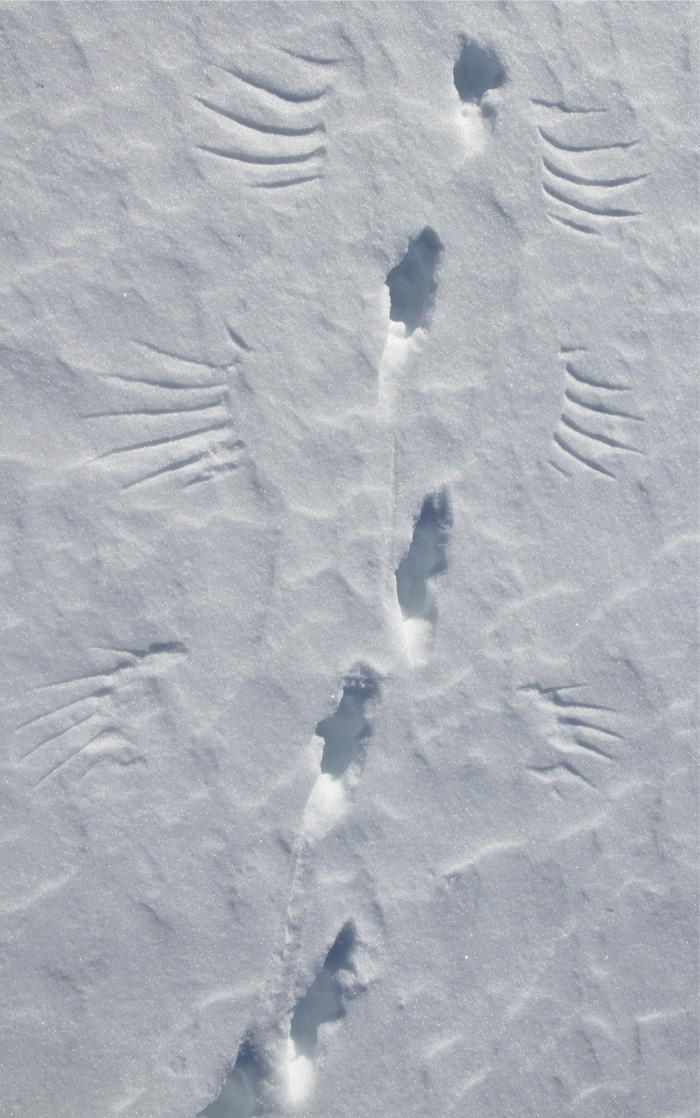
Bird footprints can be difficult to identify, but different families do leave distinctive prints. We can see five bird-foot shapes here, which in addition to their characteristic marks also reveal behavioural and ecological relationships.
Coot

Sparrows
(Tree Sparrow)

Raptors
(Common Buzzard)

Ducks
(Mallard)

Waders

Tracks of a Raven. AK.

The measurements refer to average length of the middle toe.
Pheasant
7 cm, p. 30Partridge
4.5 cm, p. 30
Quail
2.5 cm

Swan
16 cm, p. 25Goose
8 cm, p. 26
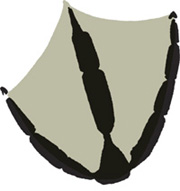
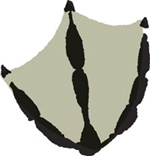
Tern
Up to 5 cm, p. 26

Capercaillie
10 cm, p. 30
Black Grouse
7 cm, p. 30

Duck
6 cm
Round hind toe, pp. 26–27

Sparrow
1.5 cm, p. 33

Carrion Crow
3 cm, p. 32
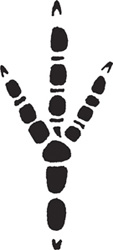
Willow Ptarmigan
4.5 cm, p. 32

Ptarmigan track in snow

Owl
8–10 cm, p. 33

Coot
12 cm, p. 27

Grey Heron
7.5 cm, p. 24
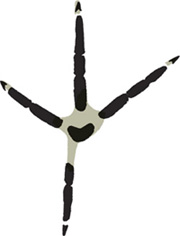
White Stork
7 cm, p. 25

Crane
8 cm, p. 25

Oystercatcher
4.5 cm, p. 29

The footprints of herons, bitterns, storks, and cranes are very similar—and all are large.
You can see the tracks of Grey Herons on soft ground at the shores of lakes and on the banks of slow-flowing streams or around fishponds. The prints are 15–17 cm long, and the imprint of the middle toe is about 9 cm. In contrast to other wading birds, Grey Heron has a long hind toe which helps it hold onto branches, so Grey Herons are able to build their nests in trees. The hind toe is 6–7 cm long and slightly offset from the front middle toe. The two toes that turn outwards are connected by webbing. Herons have powerful claws, which can be clearly identified in the footprints.
The tracks of Night Herons are similar, but 3–6 cm shorter. The toes of Bitterns are shorter and slimmer than those of Night Herons.
Frozen tracks of a Grey Heron in the ice. AK.

Grey Heron. HS.

Tracks of a Crane in the snow. UR.

The tracks of storks can be found in wet meadows and fields and in the soft mud or sand around ponds and lakes. Since it is a heavy bird, the footprints are usually very clear. The prints of the toes are shorter and broader than those of a heron, about 14–15 cm long. The middle toe is 7–8 cm long. The hind toe is only 2–2.5 cm long and can often only be seen as a small dot in the print.
Comparison of the tracks of a Grey Heron, a stork. and a Crane.

The footprints of cranes show no hind toe. Cranes are large and heavy birds, and their footprints can be seen very clearly on soft ground. The inner of the three front toes is shorter than the outer; the print is up to 16 cm in length.
Geese and swans are also heavy birds and leave clear footprints. Both species have webbing between the toes. The hind toe is very small; consequently you never see it in a print. Swans’ footprints are larger than those of geese, and the prints of both geese and swans are much larger than those of ducks, gulls, and terns.
The footprint of a swan is 11–20 cm long. The track of a Mute Swan is the largest and may reach 20 cm, though the average is about 16 cm. The track of a Whooper Swan measures 14.5 cm on average, that of Tundra Swan, 11.5 cm.
Crane. MH.


Goose footprints are about 6–12 cm long. Domestic geese leave the largest tracks; often longer than 12 cm. The footprints of Greylag Geese are 10–12 cm long. The prints of other species of goose are shorter and narrower. The footprint of a Canada Goose is about 10 cm long, that of a Bean Goose about 8 cm, and that of Brent Goose about 6 cm.
Ducks, gulls, and terns also have webbing between their three front toes, like swans and geese. Ducks normally move with their toes pointed inward, whereas the footprints of gulls are normally pretty much straight or parallel. The prints of a duck’s hind toes are often visible, but this is rarely the case with gulls and terns.
Ducks’ toes are narrower than those of geese, and the longer and more pointed claws are clearly visible. The duck’s stride is shorter than that of a goose. The hind toe of dabbling ducks leaves only a small, narrow print. The hind toe of a diving duck has a spur, and as a result leaves a larger print. The outer toe of diving ducks is longer and more curved than the middle toe. The middle toe of dabbling ducks is the longest. Mallard footprints are about 7.5–8 cm long.
Dabbling ducks sit high in the water, and their tails are always above the surface. Diving ducks sit deeper in the water, and their tail dips into the water. Dabbling ducks go ashore more regularly in search of food, and as a result you see their tracks more often.
Tracks of a Mallard in wet sand. GEH.

Brent Geese. MH.

Tracks of a Goose in the sand.

Dabbling ducks rarely dive, finding it sufficient to dip their head under the water, at which point their tail sticks up in the air. Diving ducks often dive to the bottom and can stay submerged for a long time. Diving ducks take off directly from the surface of the water, whereas dabbling ducks have to run on the surface before taking off.
The tracks of Coots are very distinctive. They have lobes on each of the three front toes. The print is about 12 cm long and about 10 cm wide. The hind toe leaves a small print.
Moorhen has long, small toes and a hind toe that is 1.5 cm long, and which often points inward. The print is about 9.5 cm long and 8 cm wide.
Grebes have restricted webbing between their feet, but do have long, wide lobes on the three front toes. The hind toe print is almost never visible. A Great Crested Grebe footprint is about 7.5 cm long and about 6.5 cm wide.
A Cormorant dries its feathers. AK.

Gulls have webbing that extends up to the claws of the three front toes. The hind toe usually leaves no print. Gulls and terns scurry around, and this is the reason you encounter many overlapping tracks. Ducks move in a more goal-oriented manner and therefore have a longer stride. The footprint of Black-headed Gull is about 4.5 cm long, Common Gull about 5 cm, Lesser Black-backed Gull 6.5–7 cm, and that of Herring and Great Black-backed Gulls about 9 cm.
In terns, the webbing between the three front toes is more restricted. The footprints are really small, since these are very light birds. The footprints’ length is about 3.5–4.5 cm.
A Cormorant has webbing between its three front toes, and its hind toe is also connected to the three front ones. The outer toe is longer than the three other toes.
The length of the footprint is up to 13 cm, the width up to 12 cm. Cormorants normally don’t go ashore. They mostly stand, relax, and dry their feathers on stumps or other man-made structures away from the shore. Cormorants’ footprints are often close together since they hop around a little at take-off. You often find tracks of a number of Cormorants in the same place.
The tracks of waders can be seen on muddy surfaces and on beaches with fine, wet sand. The footprints of the large Curlew are about 5.5 cm long, those of Woodcocks and Oystercatchers about 4.5 cm, those of Ruff about 4 cm, those of Lapwings, Snipe, and plovers are all about 3.5 cm. The footprints of Dunlin, Common Ringed Plover, Sanderling, and Ruddy Turnstone are 3 cm in length or less.
Herring Gulls at the shore. AK.

Little Stints and Dunlin look for food. HS.

You will often find small holes in the immediate vicinity of wader footprints; this is where birds have poked their beaks into the sand searching for crustaceans, worms, and other food. Occasionally you may also find the remains of a bird’s meal as well as the bird’s droppings.
Capercaillie is a large, heavy bird with strong legs; its tracks can be found on soft ground in woodland and forest. Its claws are long and leave clear prints. The hind toe is small, only about 2.5–3 cm long, but it leaves a clear impression. The three front toes are longer. The male’s footprint is about 8–12 cm long and 7–11 cm wide. In winter you can see the prints of stiff, brush-like fur between the bird’s toes. The female’s footprint is only about two-thirds the size of the male’s. You can find the prints best in winter, usually between trees in coniferous forest.
Footprints of Redshanks and Greenshanks on the mudflats, with marks made by their probing beaks. AC.

The tracks of Black Grouse resemble those of Capercaillie, but they are smaller, 7–8 cm long and 6–7 cm wide; the prints can usually be found at woodland edges, on moorland or heathland, or at lake shores, wherever grouse have their leks.
The Pheasant is a relatively heavy bird with strong legs. As is the case with other game birds, the toes have powerful claws which are used to dig in the earth. The hind toe print is very small and positioned obliquely inward relative to the front middle toe. The hind toe print is just 1–2 cm long. The footprint is 6.5–7.5 cm long and 6–6.5 cm wide. Pheasants walk or run, and this explains why you only rarely see paired prints.
Partridge tracks are similar to those of Pheasants, but are only 4.5 cm long. They are less frequently found in summer, but when birds gather in small groups in winter, you can find prints as deep rows running in a straight line.
Lapwing. MH.

Capercaillie (male). BG.

A Capercaillie track. EH.

Lapwings leave tracks on sandy soil and other soft terrain. The hind toe leaves no print since it is situated fairly high up. A Lapwing’s toes are spaced well apart; the footprint is 3.5–4 cm long and slightly broader than it is long.
A Lapwing track.


Grey Partridge. SS.

Black Grouse track. UR.

Grey Partridge track. JORN.

Grey Partridge. HBH.

Willow Ptarmigan tracks in an upland birch wood. AK.

Willow Ptarmigan have toes covered with feathers, and this means their footprints are somewhat blurred. The overall track is 4.5 cm long, and the track sequence may be seen as a winding band, especially when fresh in snow.
Willow Ptarmigan in winter plumage. AK.

Crows and jays have a hind toe that is almost exactly as long as the front middle toe. The footprint is really narrow, and all toes are equipped with long claws. The footprints of Carrion Crows are about 6.5 cm long and 3.5 cm wide; the hind toe is about 2.5 cm long. Crows often move by hopping; that is why the prints are seen together, in pairs.
You will regularly find Magpie tracks, since the birds are common in urban areas. The print is about 5 cm long and 3 cm wide; the toes are ‘calloused’ on the underside, and occasionally prints of the callouses are visible.
Pigeons have relatively powerful legs with which they can hold onto branches the way crows and jays do, but their claws are not as long, and their footprints are somewhat shorter and wider. The footprint of the Wood Pigeon is about 6 cm long and 5 cm wide; the hind toe is longer than that of any game-bird species and shorter than that of crows and jays. It is placed at an angle to the middle toe.
Footprint of a Carrion Crow. JJ.


Occasionally, on soft ground, you can find the tracks of a male dove that has circled a female during courtship.
The tracks of small birds are almost unidentifiable. Most of these passerines have a long hind toe, so they can hold onto the branches of bushes and trees. Birds often hop, but some walk. A
Blackbird’s tracks are 5.5 cm long and 3 cm wide, those of sparrows 2.5–3 cm long and about 1.5 cm wide.
Owl prints are easily recognised, since the birds have two front and two hind toes, and the tracks are very large and clear. You will frequently see claw marks. The footprint of an Eagle Owl, not including the claws, measures about 10.5 cm.
Footprint of a Meadow Pipit. LG.

A Hawk Owl has caught a mouse in the snow. MV.

Hawk Owl. HS.

Tracks of a Willow Ptarmigan taking off. AK.
